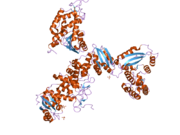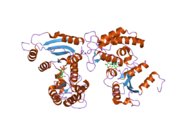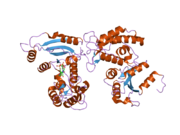CD38
CD38 (cluster of differentiation 38), also known as cyclic ADP ribose hydrolase is a glycoprotein[5] found on the surface of many immune cells (white blood cells), including CD4+, CD8+, B lymphocytes and natural killer cells. CD38 also functions in cell adhesion, signal transduction and calcium signaling.[6]
In humans, the CD38 protein is encoded by the CD38 gene which is located on chromosome 4.[7][8] CD38 is a paralog of CD157, which is also located on chromosome 4 (4p15) in humans.[9]
Function
CD38 can function either as a receptor or as an enzyme.[10] As a receptor, CD38 can attach to CD31 on the surface of T cells, thereby activating those cells to produce a variety of cytokines.[10]
CD38 is a multifunctional ectoenzyme that catalyzes the synthesis and hydrolysis of cyclic ADP-ribose (cADPR) from NAD+ to ADP-ribose in addition to synthesis of NAADP from NADP+.[11] These reaction products are essential for the regulation of intracellular Ca2+.[12] CD38 occurs not only as an ectoezyme on cell outer surfaces, but also occurs on the inner surface of cell membranes, facing the cytosol performing the same enzymatic functions.[13]
Like CD38, CD157 is a member of the ADP-ribosyl cyclase family of enzymes that catalyze the formation of cADPR from NAD+, although CD157 is a much weaker catalyst than CD38.[14] The SARM1 enzyme also catalyzes the formation of cADPR from NAD+.[13]
Clinical significance
The loss of CD38 function is associated with impaired immune responses, metabolic disturbances, and behavioral modifications including social amnesia possibly related to autism.[12][15]
CD31 on endothelial cells binds to the CD38 receptor on natural killer cells for those cells to attach to the endothelium.[16][17] CD38 on leukocytes attaching to CD16 on endothelial cells allows for leukocyte binding to blood vessel walls, and the passage of leukocytes through blood vessel walls.[9]
The cytokine interferon gamma and the Gram negative bacterial cell wall component lipopolysaccharide induce CD38 expression on macrophages.[17] Interferon gamma strongly induces CD38 expression on monocytes.[12] The cytokine tumor necrosis factor strongly induces CD38 on airway smooth muscle cells inducing cADPR-mediated Ca2+, thereby increasing dysfunctional contractility resulting in asthma.[18]
The CD38 protein is a marker of cell activation. It has been connected to HIV infection, leukemias, myelomas [19] , solid tumors, type II diabetes mellitus and bone metabolism, as well as some genetically determined conditions.
CD38 produces an enzyme which regulates the release of oxytocin within the central nervous system.[15]
Increased expression of CD38 is an unfavourable diagnostic marker in chronic lymphocytic leukemia and is associated with increased disease progression.[20]
Clinical application
CD38 has been used as a prognostic marker in leukemia.[21]
Daratumumab (Darzalex) which targets CD38 has been used in treating multiple myeloma.[22][23]
The use of Daratumumab can interfere with pre-blood transfusion tests, as CD38 is weakly expressed on the surface of erythrocytes. Thus, a screening assay for irregular antibodies against red blood cell antigens or a direct immunoglobulin test can produce false-positive results.[24] This can be sidelined by either pretreatment of the erythrocytes with dithiothreitol (DTT) or by using an anti-CD38 antibody neutralizing agent, e.g. DaraEx.
Aging studies
A gradual increase in CD38 has been implicated in the decline of NAD+ with age.[25][26] Treatment of old mice with a specific CD38 inhibitor, 78c, prevents age-related NAD+ decline.[27]
Macrophages accumulate in visceral fat and other tissues with age, leading to chronic inflammation.[28] Secretions from senescent cells induce high levels of expression of CD38 on macrophages, which becomes the major cause of NAD+ depletion with age.[29]
References
- ^ a b c GRCh38: Ensembl release 89: ENSG00000004468 – Ensembl, May 2017
- ^ a b c GRCm38: Ensembl release 89: ENSMUSG00000029084 – Ensembl, May 2017
- ^ "Human PubMed Reference:". National Center for Biotechnology Information, U.S. National Library of Medicine.
- ^ "Mouse PubMed Reference:". National Center for Biotechnology Information, U.S. National Library of Medicine.
- ^ Orciani M, Trubiani O, Guarnieri S, Ferrero E, Di Primio R (October 2008). "CD38 is constitutively expressed in the nucleus of human hematopoietic cells". Journal of Cellular Biochemistry. 105 (3): 905–12. doi:10.1002/jcb.21887. PMID 18759251.
- ^ "Entrez Gene: CD38 CD38 molecule".
- ^ Jackson DG, Bell JI (April 1990). "Isolation of a cDNA encoding the human CD38 (T10) molecule, a cell surface glycoprotein with an unusual discontinuous pattern of expression during lymphocyte differentiation". Journal of Immunology. 144 (7): 2811–5. PMID 2319135.
- ^ Nata K, Takamura T, Karasawa T, Kumagai T, Hashioka W, Tohgo A, Yonekura H, Takasawa S, Nakamura S, Okamoto H (February 1997). "Human gene encoding CD38 (ADP-ribosyl cyclase/cyclic ADP-ribose hydrolase): organization, nucleotide sequence and alternative splicing". Gene. 186 (2): 285–92. doi:10.1016/S0378-1119(96)00723-8. PMID 9074508.
- ^ a b Quarona V, Zaccarello G, Chillemi A (2013). "CD38 and CD157: a long journey from activation markers to multifunctional molecules". Cytometry Part B. 84 (4): 207–217. doi:10.1002/cyto.b.21092. PMID 23576305.
- ^ a b Nooka AK, Kaufman JL, Hofmeister CC, Joseph NS (2019). "Daratumumab in multiple myeloma". Cancer. 125 (14): 2364–2382. doi:10.1002/cncr.32065. PMID 30951198.
- ^ Chini EN, Chini CC, Kato I, Takasawa S, Okamoto H (February 2002). "CD38 is the major enzyme responsible for synthesis of nicotinic acid-adenine dinucleotide phosphate in mammalian tissues". The Biochemical Journal. 362 (Pt 1): 125–30. doi:10.1042/0264-6021:3620125. PMC 1222368. PMID 11829748.
- ^ a b c Malavasi F, Deaglio S, Funaro A, Ferrero E, Horenstein AL, Ortolan E, Vaisitti T, Aydin S (July 2008). "Evolution and function of the ADP ribosyl cyclase/CD38 gene family in physiology and pathology". Physiological Reviews. 88 (3): 841–86. doi:10.1152/physrev.00035.2007. PMID 18626062.
- ^ a b Lee HC, Zhao YJ (2019). "Resolving the topological enigma in Ca 2+ signaling by cyclic ADP-ribose and NAADP". Journal of Biological Chemistry. 294 (52): 19831–19843. doi:10.1074/jbc.REV119.009635. PMC 6937575. PMID 31672920.
{{cite journal}}: CS1 maint: unflagged free DOI (link) - ^ Higashida H, Hashii M, Tanaka Y, Matsukawa S (2019). "CD38, CD157, and RAGE as Molecular Determinants for Social Behavior". Cells. 9 (1): 62. doi:10.3390/cells9010062. PMC 7016687. PMID 31881755.
{{cite journal}}: CS1 maint: unflagged free DOI (link) - ^ a b Higashida H, Yokoyama S, Huang JJ, Liu L, Ma WJ, Akther S, Higashida C, Kikuchi M, Minabe Y, Munesue T (November 2012). "Social memory, amnesia, and autism: brain oxytocin secretion is regulated by NAD+ metabolites and single nucleotide polymorphisms of CD38". Neurochemistry International. 61 (6): 828–38. doi:10.1016/j.neuint.2012.01.030. hdl:2297/32816. PMID 22366648. S2CID 33172185.
- ^ Zambello R, Barilà G, Sabrina Manni S (2020). "NK cells and CD38: Implication for (Immuno)Therapy in Plasma Cell Dyscrasias". Cells. 9 (3): 768. doi:10.3390/cells9030768. PMC 7140687. PMID 32245149.
{{cite journal}}: CS1 maint: unflagged free DOI (link) - ^ a b Glaría E, Valledor AF (2020). "Roles of CD38 in the Immune Response to Infection". Cells. 9 (1): 228. doi:10.3390/cells9010228. PMC 7017097. PMID 31963337.
{{cite journal}}: CS1 maint: unflagged free DOI (link) - ^ Deshpande DA, Guedes A, Graeff R, Dogan S (2018). "CD38/cADPR Signaling Pathway in Airway Disease: Regulatory Mechanisms". Mediators of Inflammation. 2018: 8942042. doi:10.1155/2018/8942042. PMC 5821947. PMID 29576747.
{{cite journal}}: CS1 maint: unflagged free DOI (link) - ^ Marlein CR, Piddock RE, Mistry JJ, Zaitseva L, Hellmich C, Horton RH, Zhou Z, Auger MJ, Bowles KM, Rushworth SA (January 2019). "CD38-driven mitochondrial trafficking promotes bioenergetic plasticity in multiple myeloma". Cancer Research. 79 (9): 2285–2297. doi:10.1158/0008-5472.CAN-18-0773. PMID 30622116.
- ^ Burgler S (2015). "Role of CD38 Expression in Diagnosis and Pathogenesis of Chronic Lymphocytic Leukemia and Its Potential as Therapeutic Target". Critical Reviews in Immunology. 35 (5): 417–32. doi:10.1615/CritRevImmunol.v35.i5.50. PMID 26853852.
- ^ Deaglio S, Mehta K, Malavasi F (January 2001). "Human CD38: a (r)evolutionary story of enzymes and receptors". Leukemia Research. 25 (1): 1–12. doi:10.1016/S0145-2126(00)00093-X. PMID 11137554.
- ^ McKeage K (February 2016). "Daratumumab: First Global Approval". Drugs. 76 (2): 275–81. doi:10.1007/s40265-015-0536-1. PMID 26729183. S2CID 11977989.
- ^ Xia C, Ribeiro M, Scott S, Lonial S (October 2016). "Daratumumab: monoclonal antibody therapy to treat multiple myeloma". Drugs of Today. 52 (10): 551–560. doi:10.1358/dot.2016.52.10.2543308. PMID 27910963.
- ^ de Vooght KM, Lozano M, Bueno JL, Alarcon A, Romera I, Suzuki K, Zhiburt E, Holbro A, Infanti L, Buser A, Hustinx H, Deneys V, Frelik A, Thiry C, Murphy M, Staves J, Selleng K, Greinacher A, Kutner JM, Bonet Bub C, Castilho L, Kaufman R, Colling ME, Perseghin P, Incontri A, Dassi M, Brilhante D, Macedo A, Cserti-Gazdewich C, Pendergrast JM, Hawes J, Lundgren MN, Storry JR, Jain A, Marwaha N, Sharma RR (May 2018). "Vox Sanguinis International Forum on typing and matching strategies in patients on anti-CD38 monoclonal therapy: summary". Vox Sanguinis. 113 (5): 492–498. doi:10.1111/vox.12653. PMID 29781081. S2CID 29156699.
- ^ Camacho-Pereira J, Tarragó MG, Chini CC, Nin V, Escande C, Warner GM, Puranik AS, Schoon RA, Reid JM, Galina A, Chini EN (June 2016). "CD38 Dictates Age-Related NAD Decline and Mitochondrial Dysfunction through an SIRT3-Dependent Mechanism". Cell Metabolism. 23 (6): 1127–1139. doi:10.1016/j.cmet.2016.05.006. PMC 4911708. PMID 27304511.
- ^ Schultz MB, Sinclair DA (June 2016). "Why NAD(+) Declines during Aging: It's Destroyed". Cell Metabolism. 23 (6): 965–966. doi:10.1016/j.cmet.2016.05.022. PMC 5088772. PMID 27304496.
- ^ Tarragó MG, Chini CC, Kanamori KS, Warner GM, Caride A, de Oliveira GC, Rud M, Samani A, Hein KZ, Huang R, Jurk D, Cho DS, Boslett JJ, Miller JD, Zweier JL, Passos JF, Doles JD, Becherer DJ, Chini EN (May 2018). "+ Decline". Cell Metabolism. 27 (5): 1081–1095.e10. doi:10.1016/j.cmet.2018.03.016. PMC 5935140. PMID 29719225.
- ^ Oishi Y, Manabe I (2016). "Macrophages in age-related chronic inflammatory diseases". npj Aging and Mechanisms of Disease. 2: 16018. doi:10.1038/npjamd.2016.18. PMC 5515003. PMID 28721272.
- ^ Covarrubias AJ, Kale A, Perrone R, Newman J, Brenner C, Campisi J, Verdin E (July 31, 2019). "Aging-related inflammation driven by cellular senescence enhances NAD consumption via activation of CD38+ pro-inflammatory macrophages". bioRxiv 10.1101/609438.
Further reading
- States DJ, Walseth TF, Lee HC (December 1992). "Similarities in amino acid sequences of Aplysia ADP-ribosyl cyclase and human lymphocyte antigen CD38". Trends in Biochemical Sciences. 17 (12): 495. doi:10.1016/0968-0004(92)90337-9. PMID 1471258.
- Malavasi F, Funaro A, Roggero S, Horenstein A, Calosso L, Mehta K (March 1994). "Human CD38: a glycoprotein in search of a function". Immunology Today. 15 (3): 95–7. doi:10.1016/0167-5699(94)90148-1. PMID 8172650.
- Guse AH (May 1999). "Cyclic ADP-ribose: a novel Ca2+-mobilising second messenger". Cellular Signalling. 11 (5): 309–16. doi:10.1016/S0898-6568(99)00004-2. PMID 10376802.
- Funaro A, Malavasi F (1999). "Human CD38, a surface receptor, an enzyme, an adhesion molecule and not a simple marker". Journal of Biological Regulators and Homeostatic Agents. 13 (1): 54–61. PMID 10432444.
- Mallone R, Perin PC (2006). "Anti-CD38 autoantibodies in type? diabetes". Diabetes/Metabolism Research and Reviews. 22 (4): 284–94. doi:10.1002/dmrr.626. PMC 2763400. PMID 16544364.
- Partidá-Sánchez S, Rivero-Nava L, Shi G, Lund FE (2007). "CD38: an ecto-enzyme at the crossroads of innate and adaptive immune responses". Crossroads between Innate and Adaptive Immunity. Advances in Experimental Medicine and Biology. Vol. 590. pp. 171–83. doi:10.1007/978-0-387-34814-8_12. ISBN 978-0-387-34813-1. PMID 17191385.
- Jackson DG, Bell JI (April 1990). "Isolation of a cDNA encoding the human CD38 (T10) molecule, a cell surface glycoprotein with an unusual discontinuous pattern of expression during lymphocyte differentiation". Journal of Immunology. 144 (7): 2811–5. PMID 2319135.
- Dianzani U, Bragardo M, Buonfiglio D, Redoglia V, Funaro A, Portoles P, Rojo J, Malavasi F, Pileri A (May 1995). "Modulation of CD4 lateral interaction with lymphocyte surface molecules induced by HIV-1 gp120". European Journal of Immunology. 25 (5): 1306–11. doi:10.1002/eji.1830250526. PMID 7539755.
- Nakagawara K, Mori M, Takasawa S, Nata K, Takamura T, Berlova A, Tohgo A, Karasawa T, Yonekura H, Takeuchi T (1995). "Assignment of CD38, the gene encoding human leukocyte antigen CD38 (ADP-ribosyl cyclase/cyclic ADP-ribose hydrolase), to chromosome 4p15". Cytogenetics and Cell Genetics. 69 (1–2): 38–9. doi:10.1159/000133933. PMID 7835083.
- Tohgo A, Takasawa S, Noguchi N, Koguma T, Nata K, Sugimoto T, Furuya Y, Yonekura H, Okamoto H (November 1994). "Essential cysteine residues for cyclic ADP-ribose synthesis and hydrolysis by CD38". The Journal of Biological Chemistry. 269 (46): 28555–7. PMID 7961800.
- Takasawa S, Tohgo A, Noguchi N, Koguma T, Nata K, Sugimoto T, Yonekura H, Okamoto H (December 1993). "Synthesis and hydrolysis of cyclic ADP-ribose by human leukocyte antigen CD38 and inhibition of the hydrolysis by ATP". The Journal of Biological Chemistry. 268 (35): 26052–4. PMID 8253715.
- Nata K, Takamura T, Karasawa T, Kumagai T, Hashioka W, Tohgo A, Yonekura H, Takasawa S, Nakamura S, Okamoto H (February 1997). "Human gene encoding CD38 (ADP-ribosyl cyclase/cyclic ADP-ribose hydrolase): organization, nucleotide sequence and alternative splicing". Gene. 186 (2): 285–92. doi:10.1016/S0378-1119(96)00723-8. PMID 9074508.
- Feito MJ, Bragardo M, Buonfiglio D, Bonissoni S, Bottarel F, Malavasi F, Dianzani U (August 1997). "gp 120s derived from four syncytium-inducing HIV-1 strains induce different patterns of CD4 association with lymphocyte surface molecules". International Immunology. 9 (8): 1141–7. doi:10.1093/intimm/9.8.1141. PMID 9263011.
- Ferrero E, Malavasi F (October 1997). "Human CD38, a leukocyte receptor and ectoenzyme, is a member of a novel eukaryotic gene family of nicotinamide adenine dinucleotide+-converting enzymes: extensive structural homology with the genes for murine bone marrow stromal cell antigen 1 and aplysian ADP-ribosyl cyclase". Journal of Immunology. 159 (8): 3858–65. PMID 9378973.
- Deaglio S, Morra M, Mallone R, Ausiello CM, Prager E, Garbarino G, Dianzani U, Stockinger H, Malavasi F (January 1998). "Human CD38 (ADP-ribosyl cyclase) is a counter-receptor of CD31, an Ig superfamily member". Journal of Immunology. 160 (1): 395–402. PMID 9551996.
- Yagui K, Shimada F, Mimura M, Hashimoto N, Suzuki Y, Tokuyama Y, Nata K, Tohgo A, Ikehata F, Takasawa S, Okamoto H, Makino H, Saito Y, Kanatsuka A (September 1998). "A missense mutation in the CD38 gene, a novel factor for insulin secretion: association with Type II diabetes mellitus in Japanese subjects and evidence of abnormal function when expressed in vitro". Diabetologia. 41 (9): 1024–8. doi:10.1007/s001250051026. PMID 9754820.
External links
- CD38+Antigens at the U.S. National Library of Medicine Medical Subject Headings (MeSH)
- Human CD38 genome location and CD38 gene details page in the UCSC Genome Browser.
- GeneCard CD38 [1]
- Overview of all the structural information available in the PDB for UniProt: P28907 (ADP-ribosyl cyclase/cyclic ADP-ribose hydrolase 1) at the PDBe-KB.




















